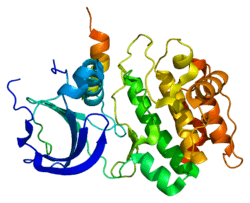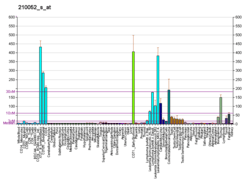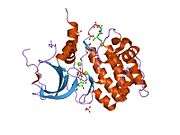TPX2
Targeting protein for Xklp2 is a protein that in humans is encoded by the TPX2 gene. [5][6][7]
Interactions
TPX2 has been shown to interact with Aurora A kinase [8], KIF15, and Ran.
References
- 1 2 3 GRCh38: Ensembl release 89: ENSG00000088325 - Ensembl, May 2017
- 1 2 3 GRCm38: Ensembl release 89: ENSMUSG00000027469 - Ensembl, May 2017
- ↑ "Human PubMed Reference:".
- ↑ "Mouse PubMed Reference:".
- ↑ Heidebrecht HJ, Buck F, Steinmann J, Sprenger R, Wacker HH, Parwaresch R (Jul 1997). "p100: a novel proliferation-associated nuclear protein specifically restricted to cell cycle phases S, G2, and M". Blood. 90 (1): 226–33. PMID 9207457.
- ↑ Zhang Y, Heidebrecht H, Rott A, Schlegelberger B, Parwaresch R (Jul 1999). "Assignment of human proliferation associated p100 gene (C20orf1) to human chromosome band 20q11.2 by in situ hybridization". Cytogenet Cell Genet. 84 (3–4): 182–3. doi:10.1159/000015251. PMID 10393424.
- ↑ "Entrez Gene: TPX2 TPX2, microtubule-associated, homolog (Xenopus laevis)".
- ↑ Kufer, Thomas A; Silljé Herman H W; Körner Roman; Gruss Oliver J; Meraldi Patrick; Nigg Erich A (Aug 2002). "Human TPX2 is required for targeting Aurora-A kinase to the spindle". J. Cell Biol. United States. 158 (4): 617–23. doi:10.1083/jcb.200204155. ISSN 0021-9525. PMC 2174010. PMID 12177045.
Further reading
- Manda R, Kohno T, Matsuno Y, et al. (1999). "Identification of genes (SPON2 and C20orf2) differentially expressed between cancerous and noncancerous lung cells by mRNA differential display". Genomics. 61 (1): 5–14. doi:10.1006/geno.1999.5939. PMID 10512675.
- Wittmann T, Wilm M, Karsenti E, Vernos I (2000). "TPX2, A novel xenopus MAP involved in spindle pole organization". J. Cell Biol. 149 (7): 1405–18. doi:10.1083/jcb.149.7.1405. PMC 2175143. PMID 10871281.
- Deloukas P, Matthews LH, Ashurst J, et al. (2002). "The DNA sequence and comparative analysis of human chromosome 20". Nature. 414 (6866): 865–71. Bibcode:2001Natur.414..865D. doi:10.1038/414865a. PMID 11780052.
- Wang Y, Han KJ, Pang XW, et al. (2002). "Large scale identification of human hepatocellular carcinoma-associated antigens by autoantibodies". J. Immunol. 169 (2): 1102–9. doi:10.4049/jimmunol.169.2.1102. PMID 12097419.
- Kufer TA, Silljé HH, Körner R, et al. (2002). "Human TPX2 is required for targeting Aurora-A kinase to the spindle". J. Cell Biol. 158 (4): 617–23. doi:10.1083/jcb.200204155. PMC 2174010. PMID 12177045.
- Gruss OJ, Wittmann M, Yokoyama H, et al. (2004). "Chromosome-induced microtubule assembly mediated by TPX2 is required for spindle formation in HeLa cells". Nat. Cell Biol. 4 (11): 871–9. doi:10.1038/ncb870. PMID 12389033.
- Garrett S, Auer K, Compton DA, Kapoor TM (2003). "hTPX2 is required for normal spindle morphology and centrosome integrity during vertebrate cell division". Curr. Biol. 12 (23): 2055–9. doi:10.1016/S0960-9822(02)01277-0. PMID 12477396.
- Strausberg RL, Feingold EA, Grouse LH, et al. (2003). "Generation and initial analysis of more than 15,000 full-length human and mouse cDNA sequences". Proc. Natl. Acad. Sci. U.S.A. 99 (26): 16899–903. Bibcode:2002PNAS...9916899M. doi:10.1073/pnas.242603899. PMC 139241. PMID 12477932.
- Heidebrecht HJ, Adam-Klages S, Szczepanowski M, et al. (2004). "repp86: A human protein associated in the progression of mitosis". Mol. Cancer Res. 1 (4): 271–9. PMID 12612055.
- Bayliss R, Sardon T, Vernos I, Conti E (2003). "Structural basis of Aurora-A activation by TPX2 at the mitotic spindle". Mol. Cell. 12 (4): 851–62. doi:10.1016/S1097-2765(03)00392-7. PMID 14580337.
- Ota T, Suzuki Y, Nishikawa T, et al. (2004). "Complete sequencing and characterization of 21,243 full-length human cDNAs". Nat. Genet. 36 (1): 40–5. doi:10.1038/ng1285. PMID 14702039.
- Cassimeris L, Morabito J (2004). "TOGp, the human homolog of XMAP215/Dis1, is required for centrosome integrity, spindle pole organization, and bipolar spindle assembly". Mol. Biol. Cell. 15 (4): 1580–90. doi:10.1091/mbc.E03-07-0544. PMC 379257. PMID 14718566.
- Beausoleil SA, Jedrychowski M, Schwartz D, et al. (2004). "Large-scale characterization of HeLa cell nuclear phosphoproteins". Proc. Natl. Acad. Sci. U.S.A. 101 (33): 12130–5. Bibcode:2004PNAS..10112130B. doi:10.1073/pnas.0404720101. PMC 514446. PMID 15302935.
- Gerhard DS, Wagner L, Feingold EA, et al. (2004). "The status, quality, and expansion of the NIH full-length cDNA project: the Mammalian Gene Collection (MGC)". Genome Res. 14 (10B): 2121–7. doi:10.1101/gr.2596504. PMC 528928. PMID 15489334.
- Maxwell CA, Keats JJ, Belch AR, et al. (2005). "Receptor for hyaluronan-mediated motility correlates with centrosome abnormalities in multiple myeloma and maintains mitotic integrity". Cancer Res. 65 (3): 850–60. PMID 15705883.
- Stewart S, Fang G (2005). "Anaphase-promoting complex/cyclosome controls the stability of TPX2 during mitotic exit". Mol. Cell. Biol. 25 (23): 10516–27. doi:10.1128/MCB.25.23.10516-10527.2005. PMC 1291225. PMID 16287863.
- Ma Y, Lin D, Sun W, et al. (2006). "Expression of targeting protein for xklp2 associated with both malignant transformation of respiratory epithelium and progression of squamous cell lung cancer". Clin. Cancer Res. 12 (4): 1121–7. doi:10.1158/1078-0432.CCR-05-1766. PMID 16489064.
- Nousiainen M, Silljé HH, Sauer G, et al. (2006). "Phosphoproteome analysis of the human mitotic spindle". Proc. Natl. Acad. Sci. U.S.A. 103 (14): 5391–6. Bibcode:2006PNAS..103.5391N. doi:10.1073/pnas.0507066103. PMC 1459365. PMID 16565220.
This article is issued from
Wikipedia.
The text is licensed under Creative Commons - Attribution - Sharealike.
Additional terms may apply for the media files.






